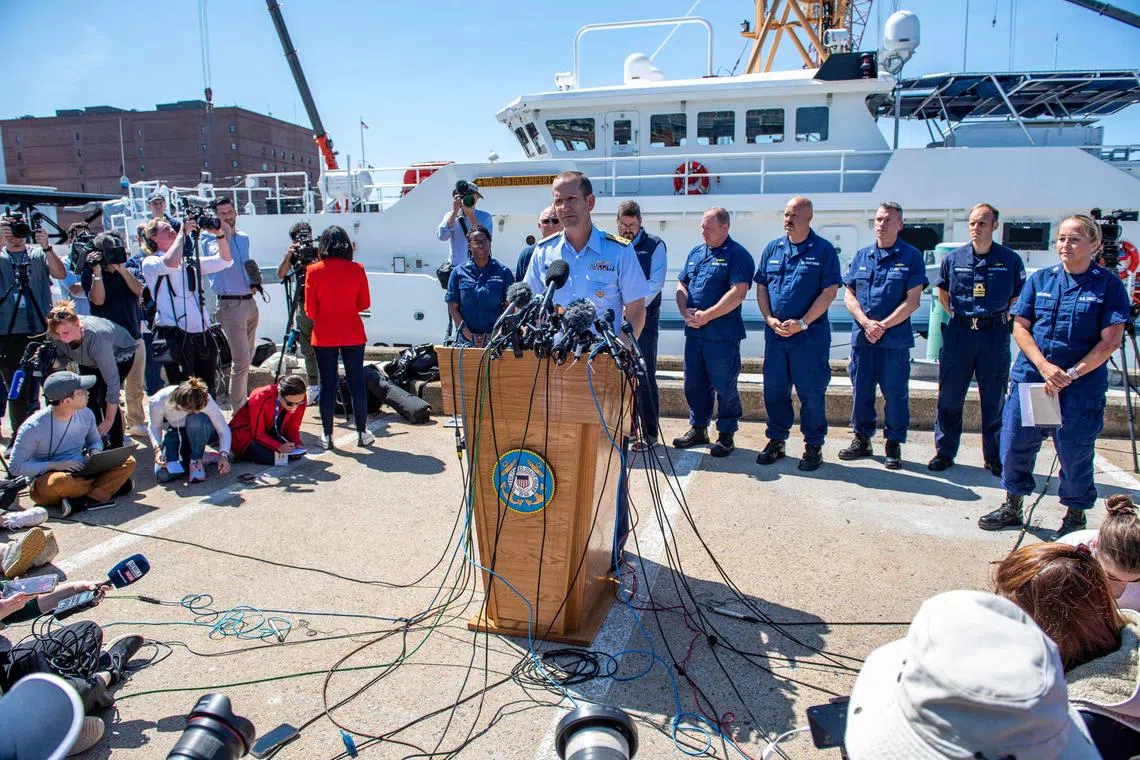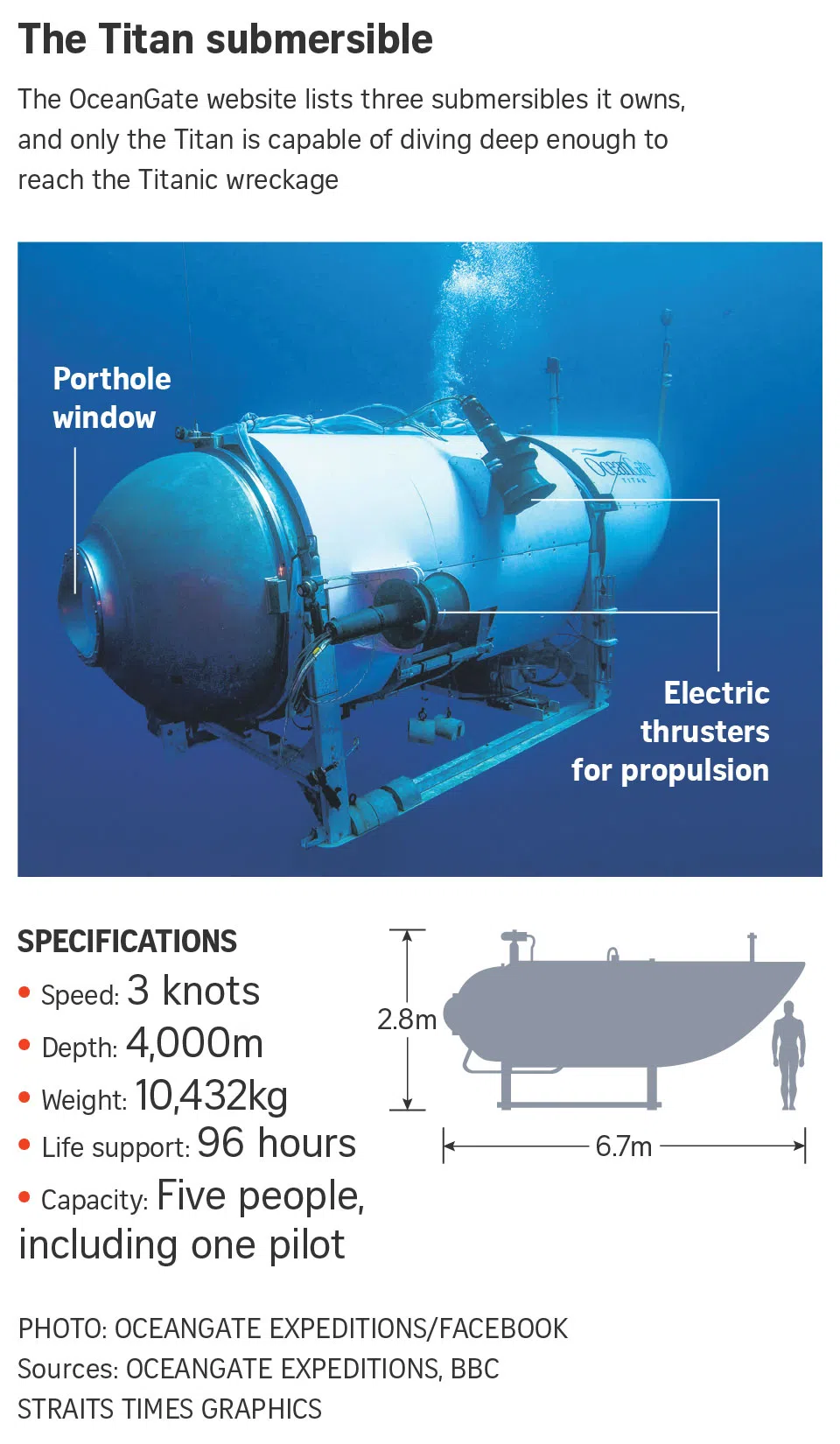Titan submersible destroyed in ‘catastrophic implosion’, all 5 aboard dead
Sign up now: Get ST's newsletters delivered to your inbox
Follow topic:
NEW YORK – Relatives and colleagues mourned on Friday submersible imploded in the North Atlantic
A robotic diving vehicle deployed from a Canadian ship discovered a debris field of the submersible Titan on Thursday morning on the seabed some 480m from the bow of the Titanic, which is about 4km beneath the surface, in a remote corner of the North Atlantic, United States Coast Guard Rear Admiral John Mauger told reporters.
The Titan was operated by the US-based company OceanGate Expeditions.
It had been missing since it lost contact with its surface support ship on Sunday morning, about an hour and 45 minutes into what should have been a two-hour dive
Five major fragments of the 6.7m-long Titan were located in the debris field left from its disintegration, including the vessel’s tail cone and two sections of the pressure hull, Coast Guard officials said.
No mention was made of whether human remains were sighted.
“The debris field here is consistent with a catastrophic implosion of the vehicle,” Rear-Adm Mauger said.
Before the Coast Guard’s press conference, OceanGate issued a statement saying there were no survivors among the five men aboard the Titan, including the company’s founder and chief executive, Mr Stockton Rush, who was piloting the submersible.
The four others were British billionaire and explorer Hamish Harding Pakistani-born businessman Shahzada Dawood 19-year-old son Suleman Titanic expert Paul-Henri Nargeolet
“These men were true explorers who shared a distinct spirit of adventure and a deep passion for exploring and protecting the world’s oceans,” OceanGate said.
“Our hearts are with these five souls and every member of their families during this tragic time.”

Rear-Admiral John Mauger said a debris field from the submersible Titan was found on the seabed some 490m from the bow of the Titanic in a remote corner of the North Atlantic.
PHOTO: AFP
Search teams and support personnel from the US, Canada, France and Britain spent days scanning thousands of square kilometres of open seas with planes and ships for any sign of the Titan.
Intense worldwide media coverage of the search largely overshadowed the aftermath of a far greater maritime disaster stemming from the wreck of a migrant vessel off the coast of Greece
Sounds from the deep
Rear-Adm Mauger said it was too early to tell when Titan met its fate. Search teams had sonar buoys in the waters for more than three days in the area without detecting any loud or violent noise
But the position of the debris field relatively close to the shipwreck and the time frame of the last communication with the Titan seemed to suggest the failure occurred near the end of its descent on Sunday.
The US Navy separately acknowledged that an analysis of its own acoustic data had detected “an anomaly consistent with an implosion or explosion
“While not definitive, this information was immediately shared” with commanders of the search mission, a senior navy official said in a statement first quoted by The Wall Street Journal.
The Journal, citing unnamed US defence officials, said the sound was picked up by a top-secret system designed to detect enemy submarines.
In an interview with Reuters on Thursday, film-maker James Cameron
“I sent e-mails to everybody I knew and said we’ve lost some friends. The sub had imploded. It’s on the bottom in pieces right now. I sent that out Monday morning,” he recounted.
Sonar buoys dropped by aircraft had picked up some sounds on Tuesday and Wednesday that temporarily offered hope that the Titan was still intact and its occupants were alive and trying to communicate by banging on the hull.
But officials said analysis of the sounds was inconclusive and that they probably emanated from something else.
“There doesn’t appear to be any connection between the noises and the location on the sea floor,” Rear-Adm Mauger said on Thursday.
Remote-controlled vehicles
Robotic craft on the seabed will continue to gather evidence, he said, but it was not clear whether recovering the victims’ remains will be possible given the nature of the accident and extreme conditions at those depths.
“We will begin to demobilise personnel and vessels from the scene over the course of the next 24 hours,” he said.
The search for the submersible had grown increasingly desperate on Thursday, when the estimated 96-hour air supply was expected to run out if the Titan were still intact.
The RMS Titanic, which struck an iceberg and sank during its maiden voyage in 1912,
The undersea expedition to the wreck, which OceanGate has been operating since 2021, cost US$250,000 (S$335,000) per person, according to its website.

Questions about Titan’s safety were raised in 2018
The sweeping search covered more than 20,000 sq km of ocean – about the size of Massachusetts state.
On Thursday, the deployment of two specialised deep-sea unmanned vehicles expanded the search farther into the ocean’s depths, where immense pressure and pitch-black darkness complicated the mission.
The fate of the tourist submersible captured global attention in part due to the mythology surrounding the Titanic.
The “unsinkable” British passenger liner has inspired both non-fiction and fiction accounts, including the blockbuster 1997 Titanic movie, which rekindled popular interest in the story. REUTERS

